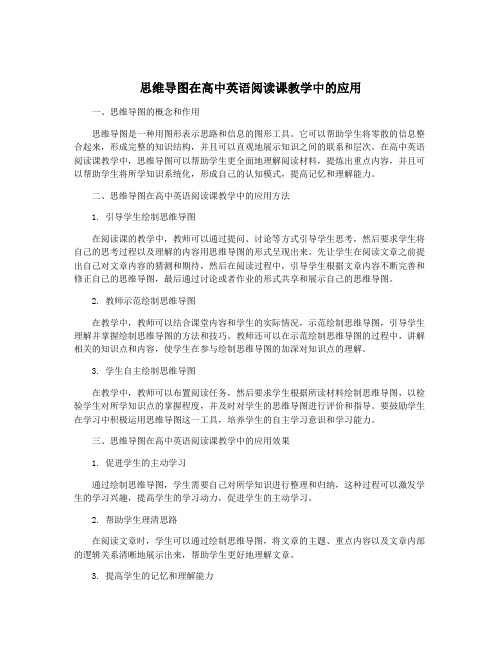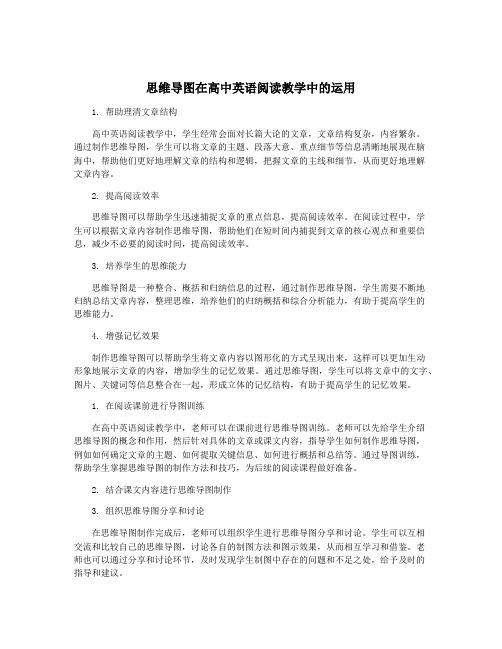思维导图在高中英语阅读文本解读中的应用
思维导图在高中英语阅读课教学中的应用

思维导图在高中英语阅读课教学中的应用一、思维导图概述思维导图是一种把主题放在中心,周围以分支方式展开的图形组织结构。
通过思维导图,可以将一个主题分解成多个关联的子主题,并以图形的方式呈现出来。
思维导图在整理知识、规划思维、梳理逻辑等方面有着独特的优势,因此被广泛应用于教学、学习、商业等领域。
二、思维导图在高中英语阅读课中的应用1.整理文章结构:在阅读一篇英语文章时,学生常常会感到内容杂乱、难以捉摸。
通过制作思维导图,可以将文章的主题、要点和细节清晰地分类和整理,使学生对文章结构有一个清晰的认识。
这样一来,学生在阅读时会更加有条理,能够更好地理解和吸收文章内容。
2.梳理文章逻辑:思维导图可以帮助学生把握文章的逻辑脉络,理清文章的论点和论据之间的关系。
通过将关键词和句子用分支的方式连接起来,可以清晰地展现文章的逻辑结构,帮助学生更好地理解作者的观点和观察文章的层次逻辑,从而提高阅读理解能力。
3.激发学生思维:在制作思维导图的过程中,学生需要对文章进行归纳、概括和延伸,这种过程可以激发学生的思维,培养他们抽象思维和逻辑推理能力。
通过思维导图,学生可以将文章中的关键信息进行概括,形成自己的思维链条,从而提高他们对文章内容的理解和分析能力。
4.帮助记忆和复习:思维导图具有图形化的特点,更加容易引起学生的兴趣。
制作思维导图不仅可以帮助学生对文章内容有一个深入的理解,还可以帮助他们更好地记忆和复习。
通过反复观看思维导图,学生可以快速回顾文章的内容,加深对文章的理解和记忆。
三、思维导图在高中英语阅读课教学中的实际应用1.导入阅读课:教师可以在开课之初,以思维导图的形式,梳理本节课的学习内容和重点,引导学生从整体上把握文章结构和内容,激发学生的学习兴趣和主动性,为学习打下坚实的基础。
2.课堂阅读:在学生阅读文章之前,可以让学生先制作思维导图,理清文章的逻辑结构和关键内容,并且在阅读过程中逐步完善思维导图,深化对文章的理解。
思维导图在高中英语阅读教学中的应用

思维导图在高中英语阅读教学中的应用思维导图是一种用于表达和组织思想的图形化工具,它可以帮助我们更好地理清思路,理解问题,解决问题。
在高中英语阅读教学中,思维导图的应用可以帮助学生更好地理解文章内容,提高阅读效率,培养学生的批判性思维能力和创造性思维能力。
本文将探讨思维导图在高中英语阅读教学中的应用,并针对不同阶段的学习目标和能力要求提出相应的教学策略。
一、思维导图在高中英语阅读教学中的基本原理思维导图是一种用图形化方式将事物、概念、观点等有机地联系起来的方法,通过图形、符号、颜色等形式,将信息以有机、系统地方式展现出来。
在高中英语阅读教学中,思维导图可以辅助学生进行文章分析、语言理解、知识整合等活动,有助于培养学生的批判性思维和整合能力。
二、思维导图在高中英语阅读教学中的应用及教学策略1. 提高阅读效率在高中英语阅读教学中,学生需要阅读大量的英语原版文章,而思维导图可以帮助学生提高阅读效率。
在阅读之前,学生可以先绘制一张思维导图,将文章的主题、关键词、重要段落等关键信息用图形、颜色等形式展现出来,这样可以帮助学生更快地理解文章的重点,提高阅读效率。
教师可以引导学生在阅读过程中不断更新思维导图,使其更加完善和系统化。
2. 深化对文章内容的理解思维导图可以帮助学生将文章中的信息组织起来,形成系统化的认知结构。
在阅读文章时,学生可以根据文章的结构、内容、观点等特点绘制相应的思维导图,将文章内容以图形化的形式展现出来,从而更好地理解文章内容。
教师可以在学生阅读完一篇文章后,引导学生用思维导图总结文章的主旨、论点、论据、结构等要素,加深对文章内容的理解。
3. 培养学生的批判性思维思维导图可以帮助学生发现文章中的逻辑关系、因果关系、对比关系等,从而培养学生的批判性思维能力。
在阅读一篇文章时,学生可以用思维导图将文章中的论点、论据、结论等要素展现出来,通过比较、分析、概括等方式,培养学生对文章的批判性思维能力。
思维导图在高中英语阅读教学中的应用①

思维导图在高中英语阅读教学中的应用①【摘要】思维导图是一种将信息以图形化方式展示的工具,在高中英语阅读教学中具有重要应用价值。
思维导图能够帮助学生整理思维,理清文章逻辑结构,提高阅读效率,并在强化记忆的过程中加深对文章内容的理解。
思维导图能够帮助学生在阅读过程中更容易地抓住重点,准确把握文章主题及关键信息,从而提高阅读理解能力。
由此可见,思维导图对高中英语阅读教学具有重要意义。
未来,随着技术的发展,思维导图有望通过更多的数字化工具和在线平台实现个性化定制,向更多领域和更广泛的学习群体推广应用。
思维导图在高中英语阅读教学中的应用是一个不容忽视的重要环节。
【关键词】思维导图、高中英语、阅读教学、应用、定义、优势、提高阅读效率、帮助理解文章、重要性、未来发展方向1. 引言1.1 思维导图在高中英语阅读教学中的应用①思维导图是一种图形化的表达工具,通过图形化的方式来展现知识之间的关联和逻辑结构。
在高中英语阅读教学中,思维导图被广泛运用,可以帮助学生更好地理解阅读材料,提高阅读效率,强化文章的理解和记忆。
思维导图不仅能够让学生更清晰地理解文章的主题和结构,还可以帮助他们整理思维,快速提取关键信息,以及有效地记忆和运用所学的知识。
通过思维导图的绘制,学生可以将文章中的关键信息和主旨整合在一张图中,从而更好地把握文章的核心内容。
思维导图还可以帮助学生建立起知识之间的联系,促进思维的联想和扩展,提高思维的灵活性和深度。
思维导图也可以激发学生的兴趣,增强学习的主动性和积极性,提高学习的效率和成果。
在未来,随着技术的不断发展,思维导图的应用将更加广泛,为高中英语阅读教学带来更多的创新和变革。
不仅是一种教学方法,更是一种促进学生综合发展的有效工具。
2. 正文2.1 思维导图的定义思维导图是一种将主题、概念、关键词等通过中心点与分支线连接起来的图形化工具。
简单来说,它就是一种将复杂信息整合、梳理、表达的方式。
思维导图通常由一个中心主题或问题开始,然后通过不同的分支展开,将相关的主题或信息用线条连接在一起,形成一个结构清晰、易于理解的图形。
思维导图在高中英语阅读教学中的应用

思维导图在高中英语阅读教学中的应用思维导图是一种功能强大的图形化思维工具,可用来记录、展示和组织各种信息和知识。
在高中英语阅读教学中,思维导图这一工具被广泛应用,因为它对学生的阅读能力和能力提升有很大的帮助。
本文将探讨思维导图在高中英语阅读教学中的应用。
1. 提高理解和回顾的效率2. 增强内在思考和分析能力思维导图可以帮助学生增强他们的内在思考和分析能力,从而更好地理解文章中的隐含含义。
通过构建思维导图,学生会主动思考和分析文章的概念和关系,由此推导出文章的提示和阐述,从而激发出他们自己的思考和分析能力。
这种思考和分析能力是一个难以取代的工具,可帮助学生从更广泛、更深入的角度理解所学的内容。
3. 促进更高水平的思维能力发展思维导图可以帮助学生进行更高水平的思考和分析,从而发展出更高水平的思维能力并提升对知识领域的掌握。
思维导图可以为学生提供一种极富创意的方式,将他们对知识领域的理解和思考转化成各种图形、图表和说理。
这可以为学生提供一个更深入和更系统地了解和学习知识的机会,从而开发出更深层次和更广泛的思维能力,并加强他们掌握知识领域的能力。
4. 与团队合作实现更好的学习效果思维导图可以帮助学生在团队合作中更好地理解和分析与学科有关的难题。
学生可以把自己的理解和分析与同伴分享,通过比较和共享的方式,进一步加深对学科的理解和认识。
学生还可以通过构建思维导图,共同组织复杂的思维和理解,探索深层次和成熟的思考模式,并换取彼此的反馈和建议。
结论思维导图是一个具有极大潜力的教育工具,尤其在高中英语阅读教学中具有重要的作用。
通过利用思维导图,学生可以提高阅读速度和效率,增强思考和分析能力,加深对知识领域的理解和认识,以及在团队合作中提高学习效果。
学校可以在课堂上加以推广该方法,鼓励学生在学习过程中灵活地运用思维导图,并帮助学生在使用过程中不断改进其效力。
思维导图在高中英语阅读课教学中的应用

思维导图在高中英语阅读课教学中的应用一、思维导图的概念和作用思维导图是一种用图形表示思路和信息的图形工具。
它可以帮助学生将零散的信息整合起来,形成完整的知识结构,并且可以直观地展示知识之间的联系和层次。
在高中英语阅读课教学中,思维导图可以帮助学生更全面地理解阅读材料,提炼出重点内容,并且可以帮助学生将所学知识系统化,形成自己的认知模式,提高记忆和理解能力。
二、思维导图在高中英语阅读课教学中的应用方法1. 引导学生绘制思维导图在阅读课的教学中,教师可以通过提问、讨论等方式引导学生思考,然后要求学生将自己的思考过程以及理解的内容用思维导图的形式呈现出来。
先让学生在阅读文章之前提出自己对文章内容的猜测和期待,然后在阅读过程中,引导学生根据文章内容不断完善和修正自己的思维导图,最后通过讨论或者作业的形式共享和展示自己的思维导图。
2. 教师示范绘制思维导图在教学中,教师可以结合课堂内容和学生的实际情况,示范绘制思维导图,引导学生理解并掌握绘制思维导图的方法和技巧。
教师还可以在示范绘制思维导图的过程中,讲解相关的知识点和内容,使学生在参与绘制思维导图的加深对知识点的理解。
3. 学生自主绘制思维导图在教学中,教师可以布置阅读任务,然后要求学生根据所读材料绘制思维导图,以检验学生对所学知识点的掌握程度,并及时对学生的思维导图进行评价和指导。
要鼓励学生在学习中积极运用思维导图这一工具,培养学生的自主学习意识和学习能力。
三、思维导图在高中英语阅读课教学中的应用效果1. 促进学生的主动学习通过绘制思维导图,学生需要自己对所学知识进行整理和归纳,这种过程可以激发学生的学习兴趣,提高学生的学习动力,促进学生的主动学习。
2. 帮助学生理清思路在阅读文章时,学生可以通过绘制思维导图,将文章的主题、重点内容以及文章内部的逻辑关系清晰地展示出来,帮助学生更好地理解文章。
3. 提高学生的记忆和理解能力通过绘制思维导图,学生可以将所学知识进行系统化整理,并且通过思维导图的形式将知识点之间的联系和层次展示出来,这有助于提高学生的记忆和理解能力。
思维导图在高中英语阅读文本解读中的运用

思维导图在高中英语阅读文本解读中的运用引言随着教育理念的不断更新和信息技术的发展,传统的教学方式逐渐被更具交互性和创造性的方法所取代。
在高中英语阅读教学中,传统的线性思维模式已经不能满足学生的学习需求,因此,思维导图作为一种有效的学习工具,被广泛地应用于英语阅读文本的解读中。
什么是思维导图思维导图是一种用图形表示思维活动的方法。
它采用分支结构和关键词的形式,将复杂的思维过程进行可视化展示。
思维导图不仅能帮助学生整理和归纳信息,还能帮助他们发现知识之间的联系,提高学习效果。
思维导图在英语阅读文本解读中的优势1.整体性思维:传统的线性阅读方式容易让学生陷入片段思维,而思维导图能够帮助学生全面地理解文章。
学生可以通过构建思维导图,将文章的主要内容、主题、观点、论证等信息整合起来,形成一个完整的认知结构。
2.概括与归纳:思维导图可以帮助学生概括和归纳文章中的重要信息。
通过将关键词和关键句子进行分类和连接,学生可以更好地掌握文章的主题、核心观点以及作者的意图。
3.信息提取:思维导图可以帮助学生提取关键信息,减少冗余和次要信息的干扰。
学生可以通过将文章中的重要信息进行筛选和提取,将重点聚焦在核心内容上,提高阅读的效率。
4.关联和扩展:思维导图有助于学生发现不同观点和知识之间的联系,促进跨学科的思维和学习。
学生可以通过构建思维导图,将不同知识点进行关联和扩展,形成更加全面和深入的理解。
思维导图在高中英语阅读文本解读中的具体应用1.文章结构分析:学生可以通过构建思维导图来分析文章的结构。
他们可以将文章的主要段落和内容进行分类和关联,帮助他们把握文章的整体结构和逻辑关系。
2.词汇梳理:学生可以使用思维导图来帮助他们梳理和记忆文章中的重点词汇。
通过将词汇进行分类和连接,学生可以更好地理解和记忆单词的意义和用法。
3.主题理解:学生可以通过构建思维导图来提取文章的主题。
他们可以将文章中的关键词和关键句子进行梳理和归纳,帮助他们更好地理解和把握文章的主要意义。
思维导图在高中英语阅读文本解读中的运用

思维导图在高中英语阅读文本解读中的运用【摘要】本文旨在探讨思维导图在高中英语阅读文本解读中的运用。
在将介绍思维导图的概念并阐述其在解读英语文本中的重要性。
接着,正文部分将揭示思维导图的原理和优势,以及如何帮助高中生解读英语文本,探讨具体应用和制作利用方法,并与其他阅读策略进行比较。
结论部分将总结思维导图在高中英语阅读文本解读中的作用,并展望其在教育领域的发展前景。
通过本文的探讨,读者将更深入地了解思维导图在英语阅读文本解读中的重要性及应用方法,从而提升高中生的阅读能力和理解能力。
【关键词】思维导图、高中英语、阅读文本解读、原理、优势、应用、制作、利用、比较、教育发展前景1. 引言1.1 介绍思维导图的概念思维导图是一种图形化的思维工具,用于将复杂信息进行整理、梳理和表达。
它通过主题词、关键词、分支、颜色等视觉元素来展示出信息之间的关联和结构,帮助人们更清晰地理解和记忆信息。
思维导图的核心思想是以中心点为核心,分支呈放射状展开,形成一个层次清晰、结构明确的图形思维结构。
思维导图可以帮助人们将复杂的信息进行简化和梳理,提高信息的整理和归纳能力。
通过思维导图,人们可以更快速地理解和掌握知识,提升学习效率。
在英语阅读文本解读中,思维导图的概念被广泛运用,可以帮助学生更好地分析和理解英语文本,挖掘其中的关键信息和主题。
思维导图的图形化展示方式能够帮助学生更直观地把握文章结构和思维逻辑,提高对文本的理解和把握能力。
通过构建思维导图,学生可以将文章中的重点内容、观点、结构等清晰地整合和展示出来,为后续的深入分析和理解提供有效的支持和指导。
思维导图在高中英语阅读文本解读中的应用,对学生的英语学习和阅读能力提升具有积极的促进作用。
1.2 阐述思维导图在高中英语阅读文本解读中的重要性思维导图可以帮助学生整理和归纳英语文本的主题和要点。
通过思维导图的制作,学生可以将文本中的关键信息以图形化的形式展现出来,帮助他们更好地理清文本的逻辑结构,把握文章的主旨和重点。
思维导图在高中英语阅读教学中的运用及探究

思维导图在高中英语阅读教学中的运用及探究思维导图是一种用图像和文字表示和组织思维的工具,它可以帮助学生整理思维,提取重点,加深理解。
在高中英语阅读教学中,思维导图可以发挥重要的作用。
本文将探讨思维导图在高中英语阅读教学中的运用以及相关研究。
1. 了解文章结构:在高中英语阅读教学中,学生常常面临复杂的文章结构,如何快速了解文章的结构对于理解和掌握文章的核心内容非常重要。
思维导图可以用来帮助学生分析文章的结构,清晰地展示文章的层次关系。
2. 提取关键词:在阅读过程中,学生需要从大量的信息中提取关键词,这些关键词对于理解文章和解决问题至关重要。
思维导图可以帮助学生提取关键词,并将其组织成有机的结构,帮助学生更好地把握文章的重点。
3. 发现主题和中心思想:主题和中心思想是文章的核心,学生需要通过阅读来发现和理解主题和中心思想。
思维导图可以帮助学生梳理文章的信息,找出关键词和文章之间的联系,从而帮助学生准确把握主题和中心思想。
4. 组织思路和写作:在高中英语阅读教学中,学生常常需要进行写作任务。
思维导图可以帮助学生组织思路,将思维进行分析和分类,并建立逻辑关系。
学生可以通过思维导图的帮助,更好地展开写作,并提高写作质量。
5. 复习与总结:学生在阅读过程中,积累了大量的知识和信息。
思维导图可以用来帮助学生进行复习与总结,整理归纳关键点,并将其信息进行关联,帮助学生提高记忆和理解的效果。
近年来,关于思维导图在高中英语阅读教学中的探究研究逐渐增多。
研究者发现,思维导图在高中英语阅读教学中的运用可以帮助学生提高对英语阅读的兴趣和主动性,提高阅读理解能力和文学素养。
一项研究发现,在高中英语阅读教学中使用思维导图能够帮助学生提高文章结构分析和解答问题的能力。
学生对文章的关键信息有了更明确的认识,更快地找到中心思想和主题,准确回答问题。
还有研究发现使用思维导图可以提高学生的写作能力。
学生利用思维导图进行写作思路的整理和组织,可以更快地展开写作,并提高写作的流畅性和连贯性。
思维导图在高中英语阅读教学中的运用及探究

思维导图在高中英语阅读教学中的运用及探究
思维导图是一种图形化的思维工具,可以帮助学生更加清晰地理解和组织知识。
在高中英语阅读教学中,思维导图的运用可以提高学生的阅读理解能力,培养学生的思维能力和创新意识。
本文将探讨思维导图在高中英语阅读教学中的具体应用。
思维导图可以帮助学生整理和归纳阅读材料中的重要信息。
在阅读一篇文章之后,学生可以根据文章内容绘制思维导图,将关键词和主要观点写在图的中心,然后通过线条和分支连接不同的观点和信息。
这样做可以帮助学生更好地理解文章的结构和组织,并提取出重要的信息和观点。
思维导图可以帮助学生分析文章的逻辑结构。
通过绘制思维导图,学生可以清晰地看到文章中的主要观点、论据和论证方法等。
他们可以将不同的观点和论据按照逻辑顺序排列,从而更好地理解文章的逻辑结构和作者的观点。
思维导图可以帮助学生发现文章中的关键词和概念。
在阅读一篇文章时,学生可以用颜色和不同的形状标记文章中的关键词和概念。
通过思维导图,学生可以更加直观地看到这些关键词和概念之间的联系和关系,从而加深对文章内容的理解和记忆。
思维导图可以帮助学生进行创新思考和扩展阅读。
在绘制思维导图的过程中,学生可以根据自己的思考和理解自由地添加新的观点和信息。
他们可以根据思维导图的分支,选择感兴趣的话题进行扩展阅读,进一步加深对相关话题的理解和掌握。
思维导图在高中英语阅读教学中的运用

参考内容
随着教育改革的深入,高中英语阅读教学越来越注重培养学生的思维能力和 语言运用能力。思维导图作为一种有效的学习策略,能够帮助学生更好地理解和 记忆阅读材料,提高阅读效率。本次演示将探讨如何将思维导图策略应用于高中 英语阅读教学中,提高学生的阅读能力和思维水平。
一、思维导图概述
思维导图是一种以图形方式呈现信息的工具,它利用色彩、线条、符号和文 字等元素,将复杂的信息组织成有逻辑关系、层次分明的图示。这种图示可以帮 助学生更好地理解信息之间的关系,加深记忆和理解。
3、课后复习
课后复习是巩固学习成果的重要环节。学生可以利用思维导图对所学内容进 行复习和巩固。他们可以根据思维导图中的信息,回忆课堂上学到的知识点,加 深对文章的理解和记忆。同时,学生还可以利用思维导图进行拓展学习,扩大知 识面。
三、思维导图在高中英语阅读中 的作用
1、提高阅读效率
通过思维导图,学生可以快速地把握文章的主题和结构,从而更快地理解文 章内容。这有助于提高学生的阅读速度和阅读效率。
因此,教师在高中英语阅读教学中应该注重引导学生运用思维导图策略,提 高学生的阅读能力和思维水平。思维导图策略在高中英语阅读中的运用
思维导图,作为一种可视化学习工具,正逐渐在高中英语阅读中发挥重要作 用。通过思维导图的运用,学生能够更有效地理解和分析阅读材料,提升阅读理 解能力。本次演示将探讨思维导图在高中英语阅读中的运用策略。
2、课堂教学:在课堂教学中,教师可利用思维导图引导学生分析文章结构, 把握文章大意。同时,教师可将文中出现的新词汇、短语和句型等知识点融入到 思维导图中,帮助学生更好地理解和记忆。学生则可以在思维导图的引导下,积 极参与课堂讨论,提高阅读能力和思维能力。
3、课后复习:课后,学生可以利用思维导图进行复习,巩固所学知识。同 时,学生还可以根据自己对文章的理解,自行设计思维导图,提高自主学习能力。
思维导图在高中英语阅读教学中的应用与分析

思维导图在高中英语阅读教学中的应用与分析思维导图是一种图形化的思维整理工具,以树状结构图的形式将信息和关系清晰地展示出来。
在高中英语阅读教学中,应用思维导图能够帮助学生更好地理解和记忆文章内容,提高阅读技巧和思维能力。
本文将从思维导图的定义、特点和优势开始,分析其在高中英语阅读教学中的应用,并探讨其效果和局限性。
一、思维导图的定义、特点和优势思维导图是一种将信息和关系以图形方式展示的工具。
它以核心主题为中心,通过分支展开,将相关信息有机地整合在一起,形成树状结构。
特点包括:一、简洁明了,可以一目了然地看出主题和分支之间的关系;二、分支丰富,可将各种细节和信息有序地连接起来;三、层次清晰,能够将重点和次要内容区分开来。
思维导图在高中英语阅读教学中具有以下优势:一、帮助学生整理信息。
在阅读过程中,学生需要面对大量的信息,思维导图能够让他们快速梳理和理解文章的结构和关键信息;二、激发学生思维。
思维导图能够让学生进行关联思维和拓展思维,在梳理信息的同时发散出更多的观点和想法;三、培养学生归纳总结的能力。
通过制作思维导图,学生需要对文章内容进行分类和总结,提高归纳总结的能力。
二、思维导图在高中英语阅读教学中的应用1.文章结构分析在阅读一篇文章之前,学生可以先根据标题、副标题和段落开头的主题句等信息制作思维导图,将文章的结构图清晰地展示出来。
这样做可以帮助学生更好地理解文章的主旨和逻辑关系,提高整体把握能力。
2.语言点梳理在阅读过程中,学生需要面对大量的生词、短语和句型。
思维导图可以将这些语言点分类整理,帮助学生记忆和区分使用。
同时,通过分支的拓展,学生还可以自行添加例句、语境等,提高语言点的应用能力。
3.表达方式归纳在阅读过程中,学生需要学会运用不同的表达方式来表达相同的意思。
思维导图可以将这些表达方式列举出来,并进行对比和总结。
通过制作思维导图,学生可以更好地理解和掌握各种表达方式,提高写作和口语表达的能力。
思维导图在高中英语阅读教学中的运用

思维导图在高中英语阅读教学中的运用1. 帮助理清文章结构高中英语阅读教学中,学生经常会面对长篇大论的文章,文章结构复杂,内容繁杂。
通过制作思维导图,学生可以将文章的主题、段落大意、重点细节等信息清晰地展现在脑海中,帮助他们更好地理解文章的结构和逻辑,把握文章的主线和细节,从而更好地理解文章内容。
2. 提高阅读效率思维导图可以帮助学生迅速捕捉文章的重点信息,提高阅读效率。
在阅读过程中,学生可以根据文章内容制作思维导图,帮助他们在短时间内捕捉到文章的核心观点和重要信息,减少不必要的阅读时间,提高阅读效率。
3. 培养学生的思维能力思维导图是一种整合、概括和归纳信息的过程,通过制作思维导图,学生需要不断地归纳总结文章内容,整理思维,培养他们的归纳概括和综合分析能力,有助于提高学生的思维能力。
4. 增强记忆效果制作思维导图可以帮助学生将文章内容以图形化的方式呈现出来,这样可以更加生动形象地展示文章的内容,增加学生的记忆效果。
通过思维导图,学生可以将文章中的文字、图片、关键词等信息整合在一起,形成立体的记忆结构,有助于提高学生的记忆效果。
1. 在阅读课前进行导图训练在高中英语阅读教学中,老师可以在课前进行思维导图训练。
老师可以先给学生介绍思维导图的概念和作用,然后针对具体的文章或课文内容,指导学生如何制作思维导图,例如如何确定文章的主题、如何提取关键信息、如何进行概括和总结等。
通过导图训练,帮助学生掌握思维导图的制作方法和技巧,为后续的阅读课程做好准备。
2. 结合课文内容进行思维导图制作3. 组织思维导图分享和讨论在思维导图制作完成后,老师可以组织学生进行思维导图分享和讨论。
学生可以互相交流和比较自己的思维导图,讨论各自的制图方法和图示效果,从而相互学习和借鉴。
老师也可以通过分享和讨论环节,及时发现学生制图中存在的问题和不足之处,给予及时的指导和建议。
4. 引导学生独立制作思维导图在阅读课程的后期,老师可以逐渐引导学生独立进行思维导图制作。
思维导图在高中英语阅读教学中的运用

思维导图在高中英语阅读教学中的运用一、思维导图概念和特点思维导图是一种以中心点为核心,结合文字、图形、颜色等多种符号,将主题与分支观点有机结合的思维工具。
它以一种树状结构来呈现信息,具有高度概括性、可视化、逻辑清晰、易于理解和记忆等特点。
通过思维导图,学生可以将零散的信息进行整合,形成系统性的知识结构,帮助他们更好地理解和记忆知识。
1. 提高阅读理解能力在高中英语学习中,阅读理解是一个重要的学习能力,也是学生学习英语的基本功。
而通过思维导图来整理阅读材料的内容,可以帮助学生将信息整合成一个有机的体系,帮助他们更好地理解文章的内容和结构,提高阅读理解的能力。
2. 培养词汇和语法运用能力在思维导图中,学生可以将文章中的重点词汇和语法结构进行标记,帮助他们更好地理解和记忆这些重要的语言元素。
通过不断地运用思维导图,学生可以加深对词汇和语法知识的理解,从而提高语言运用能力。
3. 拓展语言思维思维导图能够激发学生的联想和想象力,帮助他们在阅读过程中形成更多的联想和思考。
通过思维导图,学生可以将阅读材料中的信息与自己已有的知识进行联系,从而促进语言思维的拓展。
4. 培养逻辑思维思维导图是一种以逻辑为基础的思维工具,通过思维导图的运用,可以培养学生的逻辑思维能力。
学生在使用思维导图整理阅读材料时,需要按照一定的逻辑顺序进行思考和整理,这有助于提高他们的逻辑思维能力。
1. 选择合适的阅读材料在进行思维导图的教学过程中,首先需要选择合适的阅读材料。
这些材料可以是课本上的文章,也可以是与课文相关的其他阅读材料,如新闻报道、科普文章等。
选择合适的阅读材料能够让学生在运用思维导图的过程中得到更好的锻炼。
2. 指导学生使用思维导图在开始使用思维导图进行阅读的教学过程中,需要给学生进行一定的指导。
这包括如何建立思维导图的中心主题、如何将主题与分支观点进行有机结合、如何选择合适的符号和颜色等。
这些指导能够帮助学生更好地掌握思维导图的使用方法。
思维导图在高中英语记叙文阅读教学中的应用

思维导图在高中英语记叙文阅读教学中的应用随着人们对于英语阅读教育的重视,越来越多的英语阅读教育方法被引入到教学当中。
思维导图,作为最为常用的一种思维工具,在英语阅读教学中也可以得到较为广泛的应用。
本文将从以下三个方面介绍思维导图在高中英语记叙文阅读教学中的应用。
一、提高学生阅读思维传统的阅读教学,学生通常只是停留在词汇、语法、结构等表面上。
但是阅读英语记叙文除了要理解表达的文字外,更重要的是理解作者所表达的思想和意图。
而这些内容往往是在文本中不容易直接寻找到的。
因此,在高中英语记叙文阅读教学中,思维导图可以很好的帮助提高学生的阅读思维。
学生可以利用思维导图对故事的前因后果、人物关系、故事情节等作出总体统合,更好地理解故事的内涵,从而提高阅读的深度和广度。
此外,思维导图可以让学生在整理重要信息时,剔除无关信息,从而进一步提高阅读的速度和准确度。
二、提高学生记忆效果思维导图在英语阅读教学中还可以用来提高学生记忆效果。
记叙文故事中,人物关系错综复杂,如果要求学生把所有人物都记下来,很容易造成学生的逆反情绪。
而利用思维导图,学生可以根据自己的理解,在关键位置画出主要人物的名字,并结合相关的关键词,更好地理解其身份、性格、行为等,从而增加记忆效果。
另外,思维导图可以将学生对于阅读的理解整合起来,故事中的细节、事件等都可以从不同的角度和思路进行分类、归纳和总结,从而加深对于文章的记忆和理解。
三、提高学生写作能力思维导图也可以用来提高学生的写作能力。
记叙文故事的结构大致包括开头、正文和结尾,而每个部分的内容涵盖了丰富的写作技巧和表达方法。
通过绘制思维导图,学生可以根据自己对于故事的理解,将故事的重点和高潮、故事的发展和转折点等进行归纳,从而通过模仿练习,更好地掌握记叙文的写作技巧和写作方法,从而提高写作质量。
思维导图在高中英语阅读教学中的应用探究

思维导图在高中英语阅读教学中的应用探究一、引言二、思维导图在高中英语阅读教学中的理论基础1. 认知心理学的视角思维导图是由英国心理学家托尼·比克尔(Tony Buzan)提出,其理论基础主要是认知心理学,认为人的思维是一种联想思维,思维导图可以帮助学生将分散的信息整合在一起,形成更为有机的知识结构,提高信息的连接度和联想度,从而更容易记忆和理解。
在高中英语阅读教学中,学生在阅读文章时,思维导图可以帮助他们将文章中的信息有机地整合起来,形成更为清晰的认知结构。
2. 语言学习理论的支持“输入假设”理论认为语言习得是通过接受大量的输入来完成的,而思维导图可以帮助学生整合和理解大量的阅读材料,有助于提高学生的英语输入量。
“输出假设”理论认为语言的输出过程是语言习得的重要环节之一,而思维导图的制作过程就是一次语言输出的过程,可以促进学生对语言知识的整合和运用,提高其语言表达能力。
1. 思维导图在阅读材料的整合和理解中的应用在高中英语阅读教学中,学生需要阅读大量的文章和材料,通过思维导图的制作,可以帮助学生将所阅读的内容进行整合和归纳。
学生可以在阅读后,利用思维导图将文章中的主要观点、关键词语、重要事实等整合在一张图上,形成一个完整的信息网络,方便他们进行复习和回顾,在长期记忆中保留并加深对阅读材料的理解。
2. 思维导图在写作训练中的应用在高中英语阅读教学中,写作是一个重要的环节。
通过思维导图的制作,可以帮助学生在阅读后构思文章的主题和思路,在脑海中形成一张清晰的“地图”,有助于他们写出条理清晰、思路清晰、内容丰富的英语文章。
3. 思维导图在语言表达训练中的应用思维导图的制作是一个融合图像、文字和语言的过程,可以帮助学生整合和提高语言知识。
在思维导图的制作过程中,学生需要提炼关键词汇、整合句子结构、构建语言逻辑,这些都是英语语言表达的重要能力。
通过思维导图的制作,学生能够提高自己的语言表达能力,为以后的英语学习打下坚实的基础。
思维导图在高中英语阅读教学中的应用探究

思维导图在高中英语阅读教学中的应用探究一、思维导图概述思维导图是一种以树状结构来表示关联思维的图形工具。
它以中心主题为核心,通过多个分支和子分支展开,同时使用图形符号和关键词来表示关系和连接。
思维导图可以帮助学生整理知识、提高记忆和提取关键信息的能力。
1. 激发学生的学习兴趣思维导图可以将抽象的英语阅读内容进行可视化展示,通过图形和颜色的运用增强学生的感知和记忆,从而激发学生的学习兴趣。
学生可以根据思维导图的结构和主题来进行多层次的阅读,提高阅读的效果和成就感。
2. 增强学生的理解能力思维导图可以帮助学生将英语阅读内容进行分块,并通过线条和关键词来表示不同的层次和关联。
学生可以通过思维导图来分析、归纳和总结文中的信息,提高对文章逻辑结构和作者观点的理解能力。
3. 培养学生的阅读策略思维导图可以帮助学生建立起层次分明的思维结构,引导学生使用各种阅读策略,如预测、推断、概括等。
学生可以根据思维导图来制定自己的阅读计划和策略,提高阅读的效率和准确性。
4. 帮助学生记忆和复习思维导图可以将英语阅读内容进行梳理和整理,帮助学生提取和归纳关键信息。
学生可以通过思维导图来进行复习和记忆,提高记忆的持久性和复习的效果。
思维导图也可以帮助学生发现知识点之间的联系和重要性,从而有助于知识的组织和迁移。
5. 培养学生的创造思维和批判思维思维导图可以帮助学生进行创造性的思考和批判性的分析。
学生可以通过思维导图来展开自己的想象和思考,提出自己的观点和看法。
思维导图也可以帮助学生对文中观点进行分析和评估,培养学生的批判思维和判断能力。
1. 阅读前的准备工作2. 阅读过程中的指导在阅读过程中,教师可以引导学生使用思维导图进行分析和归纳,帮助他们提取和总结关键信息。
教师可以提供一些思维导图的模板和示例,或者提供一些问题来引导学生进行思维导图的制作和应用。
3. 阅读后的总结和复习在阅读结束后,教师可以要求学生根据思维导图来进行总结和复习。
思维导图在高中英语阅读教学中的应用与分析

思维导图在高中英语阅读教学中的应用与分析引言思维导图是一种图形化的知识组织工具,可以帮助学生将复杂的信息结构化,并促进思维的整合与联想。
在高中英语阅读教学中,思维导图作为一种辅助工具,能够帮助学生更好地理解和分析英语文本,提高阅读效果。
本文将从实际应用和分析两个方面,探讨思维导图在高中英语阅读教学中的应用及其效果。
思维导图在高中英语阅读教学中的应用1. 文本理解与概括在阅读英语文章时,学生往往会遇到大量的信息,无法快速理解和整合。
思维导图可以帮助学生将文本中的关键信息提取并组织,形成概括性的思维导图。
通过整理思维导图,学生可以更好地理解文章的主旨和重点,提高阅读效率。
2. 逻辑分析与推理思维导图也可以帮助学生进行逻辑分析和推理。
通过制作思维导图,学生可以将文章中的因果关系、转折关系等重要信息进行整合,从而帮助他们更好地理解文章的逻辑结构和作者的观点。
同时,思维导图还可以促使学生进行推理和思考,提高他们的逻辑思维能力。
3. 词汇拓展与记忆阅读英语文章时,学生经常会遇到大量的生词和短语。
思维导图可以帮助学生将这些生词和短语进行分类和拓展,形成一个词汇网络。
通过制作思维导图,学生可以更好地理解和记忆英语词汇,提高他们的词汇运用能力。
4. 图文结合与联想思维导图的图文结合特点,可以帮助学生将文字和图像进行联想并结合起来。
在阅读英语文章时,学生可以通过思维导图将文本中的关键词与相关的图片进行关联,帮助他们更深入地理解和记忆文章的内容。
这种联想和结合有助于提高学生的观察能力和想象力。
思维导图在高中英语阅读教学中的分析1. 促进学生主动思考思维导图在高中英语阅读教学中的应用可以帮助学生主动思考,通过整理思维导图,学生需要主动筛选、梳理和整合文本信息,提高他们的学习主动性和问题解决能力。
2. 培养学生的思维技巧通过制作思维导图,学生可以培养和提高自己的思维技巧,比如分类、概括、推理和归纳等。
这些思维技巧在阅读英语文章时起到了重要的辅助作用,帮助学生更好地理解和分析文本。
思维导图在高中英语阅读教学中的运用

思维导图在高中英语阅读教学中的运用1. 引言1.1 背景介绍思维导图通过图形化的方式呈现信息,帮助学生更好地理清思维,梳理知识,提高学习效率。
在传统的英语阅读教学中,学生常常面临着信息过载、理解困难等问题,而思维导图的引入可以有效地帮助学生建立知识之间的连接,提升他们的思维能力和学习兴趣。
在这样的背景下,探讨思维导图在高中英语阅读教学中的运用,对于提升学生的阅读能力、激发学习兴趣具有重要的意义。
研究思维导图的具体运用方法和案例分析,可以为教师提供更多实用的指导,从而更好地指导学生进行英语阅读。
1.2 研究意义思维导图能够帮助学生更好地理清文章结构,把握文章主要内容和重点细节,从而提高阅读效率和理解能力。
思维导图可以帮助学生建立知识之间的联系,形成完整的知识体系,加深对知识的理解和记忆。
通过思维导图的绘制和分析,学生可以培养逻辑思维和批判性思维能力,提高解决问题的能力和水平。
最重要的是,思维导图可以激发学生学习的兴趣,增强学习的自觉性和主动性,从而达到更好的学习效果。
研究思维导图在高中英语阅读教学中的运用,不仅有助于提高学生的阅读能力和学习效果,还可以为英语教学方法的创新和教学理念的完善提供有益的参考。
2. 正文2.1 思维导图的定义思维导图是一种图形化的工具,用于呈现和组织信息。
它通常由一个中心主题或问题开始,然后分支出不同的子主题和相关的关键词。
思维导图可以帮助人们更清晰地理解和记忆信息,同时也可以帮助他们发现信息之间的关联性和层次结构。
思维导图通常采用非线性的方式展示信息,这有助于激发人们的创造性思维和解决问题的能力。
在高中英语阅读教学中,思维导图可以帮助学生整理和理解复杂的英语文章。
通过构建思维导图,学生可以将文章中的重点内容和关键信息提取出来,然后以图形化的方式展示出来。
这不仅有助于学生更深入地理解文章的内容,还能帮助他们更好地记忆和复习文章中的知识点。
思维导图是一种非常有效的工具,可以帮助学生在高中英语阅读教学中更好地理解和应用知识。
思维导图在高中英语阅读教学中的运用及探究

思维导图在高中英语阅读教学中的运用及探究思维导图是一种通俗易懂的知识组织工具,它将文字、图像、符号等元素有机地结合在一起,帮助人们更好地理清思路,理解知识,提高学习效率。
在高中英语阅读教学中,思维导图能够帮助学生梳理文章结构,把握文章核心,提升阅读理解能力。
本文将从思维导图的定义、特点及在高中英语阅读教学中的具体运用等方面展开探讨。
一、思维导图的定义思维导图是由英国心理学家托尼·布赖恩提出的,它是一种以中心词为枢纽,从中心向外辐射状展开的图形思维工具。
思维导图以中心词为核心,通过主线、分支、颜色、图形等形式呈现出关键词与关键词之间的关联,呈现出层次建构的关联性思维模式。
思维导图主要有以下特点:1. 图形化思维:思维导图采用图形和颜色等形式呈现思路,更直观、生动,便于记忆和理解。
2. 层次性思维:思维导图通过层次性的展开结构,使得概念之间的关联更加清晰,帮助人们更好地理解和记忆知识。
3. 灵活性:思维导图能够根据思维的展开和延伸随时调整,更符合人们的思维规律。
4. 有机整合:思维导图能够将文字、图像、符号等元素有机整合在一起,构建完整的知识结构。
1. 文章梳理:在阅读一篇英语文章时,学生可以通过制作思维导图,将文章的中心思想作为中心词,然后展开主题、分支及细节,帮助学生梳理文章结构,把握重点。
2. 关键词标注:学生可以用不同颜色、图形或符号来标注文章中的关键词、关键句,以便更快速地捕捉文章核心内容。
3. 逻辑关系呈现:通过思维导图,学生可以清晰地呈现文章中不同观点、论据之间的逻辑关系,帮助学生更好地理解文章的思想脉络。
4. 内容梳理与总结:在阅读完文章后,学生可以通过制作思维导图,对文章内容进行梳理与总结,帮助学生更加深刻地理解文章,并加深对文章内容的记忆。
5. 阅读策略引导:可以使用思维导图引导学生运用不同的阅读策略,比如预测、推理、概括、归纳等,帮助学生更全面地理解文章内容。
三、思维导图在高中英语阅读教学中的意义1. 帮助学生梳理文章结构,把握文章主题和重点,提升阅读理解能力。
思维导图在高中英语阅读教学中的应用①

思维导图在高中英语阅读教学中的应用①思维导图是一种将信息以图形化的方式呈现的工具,可以帮助学生整理和梳理知识,增强记忆和理解能力。
在高中英语阅读教学中,思维导图具有以下应用价值:1. 激发学生的阅读兴趣:通过绘制思维导图,可以将抽象的英语阅读内容转化为可视化的图形,增加对阅读内容的兴趣和好奇心,激发学生的学习热情。
2. 整理和归纳阅读内容:思维导图可以帮助学生将文章的主要内容进行整理和归纳,从而提高学生的思维逻辑能力。
通过将主题、重点、细节等信息以图形的方式表现出来,学生可以更加清晰地理解和记忆文章的结构和内容。
3. 帮助学生理解文章上下文关系:在阅读英语文章的过程中,学生常常会遇到理解句子和段落之间逻辑关系的困难。
思维导图可以帮助学生将文章中的上下文关系以图形的方式展示出来,使学生更加清晰地理解句子和段落之间的逻辑关系。
4. 培养学生的主动阅读和独立思考能力:通过绘制思维导图,学生需要将阅读内容进行概括和总结,并以自己的方式将其展示出来。
这样的过程可以培养学生的主动阅读和独立思考能力,提高学生在阅读过程中的参与度和学习效果。
5. 促进学生和教师之间的互动和合作:思维导图可以作为学生和教师之间的交流工具,在教学过程中促进学生和教师的互动和合作。
学生可以通过思维导图将自己的理解和思考展示给教师,教师可以根据学生的思维导图为学生提供反馈和指导,从而实现更有效的教学。
思维导图在高中英语阅读教学中具有诸多应用价值。
通过思维导图的应用,可以激发学生的阅读兴趣,整理和归纳阅读内容,帮助学生理解文章上下文关系,培养学生的主动阅读和独立思考能力,促进学生和教师之间的互动和合作。
思维导图在高中英语阅读教学中是一种非常有效的教学工具。
- 1、下载文档前请自行甄别文档内容的完整性,平台不提供额外的编辑、内容补充、找答案等附加服务。
- 2、"仅部分预览"的文档,不可在线预览部分如存在完整性等问题,可反馈申请退款(可完整预览的文档不适用该条件!)。
- 3、如文档侵犯您的权益,请联系客服反馈,我们会尽快为您处理(人工客服工作时间:9:00-18:30)。
第十二届全市基础教育课程改革征文大赛论文类别:中学英语思维导图在高中英语阅读文本解读中的应用靳驰:重庆市璧山区来凤中学摘要:英语阅读中运用思维导图分析,能使困难、复杂的内容非常清晰、系统地凸显出来,因而能帮助学生更深刻地理解所学内容,更容易地组织和记住所读材料,也有助于组织语言材料进行写作练习。
文章讨论了思维导图类型、文本解读以及理论依据,给出了思维导图分析范例。
研究发现思维导图对教师自身文本解读能力的提高、学生思维能力的发展和阅读教学质量的提升都产生了积极的作用。
关键词:思维导图;高中英语;文本解读一、概述所谓思维导图又称为概念图(concept maps) ,是指一套概念及其联系的两维表达方式(two - dimensional representations of a set of concepts and their relationships) (Novak & Gowin ,1984) 。
概念,是指用某种标志(label) 来表示的某事件或物体,这种标志往往是一个词,有时是某种符号。
图式通常包含一系列被放置在方框或圆圈中的概念,中间用线连接起来,连线上的词语表明两个概念之间的关系。
英语的阅读教学中,将阅读材料中最重要的信息进行组织整理,并用自己的语言将它转换成系列图式的形式,使概念之间形成体系和层次,并能方便交互。
这样,运用图式分析可以使得困难、复杂的内容非常清晰、系统地凸显出来,因而能帮助我们更深刻地理解阅读内容,更容易地组织和记住所读材料,也有助于组织语言材料进行写作练习。
二、思维导图类型1. 图表型(Charts) :用图表型图式来对人物、地点、事件、观点、质量、描述或数据等进行比较。
(to compare and contrastpeople , places , events , ideas , qualities , descriptions , or facts) 。
关键性的问题有:What things are being compared ? How are they similar ? How are they different ?2. 大脑风暴型(brainstorm) :又称为蛛网型(Spiders) ,用来描述中心思想、概念及其支撑说明(central idea or concept withsupport) ,或表示主题、描述等的主次关系及相互联系。
(to show primary - secondary relationships or inter relationships of themes or descriptions ,etc. ) 。
关键性的问题有: What is the central idea ?What are its attributes ?What are its functions ?(MI =Main Idea ,SI = Supporting Idea/Major Detail ,D = Detail)3. 树型(Trees) :又称为分层结构目录(Hierarchies) ,用来表明类别、分类、分析、结构、描述和举例。
(to show categories ,classifications , analysis , structures , descriptions , and examples) 。
关键性的问题有:What is the superordinate category ? What are the subordinate categories ? How are they related ? How many levels are there ?4. 链型(Chains) :用来表明过程、原因、结果、时间顺序和步骤。
(to show processes , sequences , causes and effects , chronological order , and steps) 。
关键性的问题有:What happened first? What happened next? What happened last? 等。
5. 解决问题型(Problem/ Solution) :用来表明问题、解决措施以及结果。
( to show a problem , attempted solutions and results) 。
关键性问题有:What was the problem ? Who had the problem? Why was it a problem ? What attempts were made to solve the problem ? Did those attempts succeed ? 等。
6. 互动型(interaction) :表示人与人之间或团体之间的相互关系。
关键性的问题有:Who are the persons or groups ? Whatwere their goals ? Did they conflict or cooperate ? What was the out come for each person or group ? 等。
7. 草图型(Sketches) :用来表示物体结构、视觉图像、具体物体、空间关系和地方描述。
(Use to show physical structures ,visual images , concrete objects , spatial relationships , and descrip tions of places)8. 循环型(Circle) : 用来表示事物的循环变化,如天气的变化、成功与失败的循环、人生的周期等(to show how a series of events interact to produce a set ofresults again and again , like weather phenomena , cycles of achievement and failure , the life cycle) 。
关键性的问题有: What are the critical events in the cycle ? How are they related ? In what ways are they self - reinforcing ?三、文本解读与思维导图一堂好的英语阅读课常常是学生、教师、文本三者相互作用的产物,这种相互作用最早发生在教师与文本之间,即教师在设计施教方案之前需要对阅读文本进行正确的、全面的和深入的理解,以便充分挖掘文本材料的教学价值,提高阅读教学的有效性。
我们把英语教师对文本信息的把握过程称为阅读文本的解读。
这一过程不仅是有效阅读教学的开始,也是英语教师专业发展的需要。
“text”一词源于拉丁文的texere,中文译成“文本”,指任何由书写所固定下来的话语。
从语言学角度看,文本是语义上完整的语段,可长可短,短则一个单词,长则一章节,它与功能主义语言学家韩礼德提出的“语篇”概念吻合,因而“text”也常作“语篇”翻译。
解读指通过分析来理解,它是个动态的建构过程,需要读者借助一定的阅读技巧与策略及已有背景知识对语言符号进行信息的预测、处理,加以理解、接受,建构起与主题相关的图式,如结构图式、体裁图式、语言图式和语境图式。
这些图式围绕某一个主题将文本中的信息符号、语言符号和读者已有的知识经验联系起来,建构内在的知识结构。
作为一种图式工具,思维导图可以把人脑中的隐形知识显性化,以图的直观性特征对当前所学新内容加以定向与引导,使学习者看到概念之间的关系,并能够从与新知识实质性联系中或者从与新知识相关或公共的属性中找到同化、吸收当前新知识的固着点,从而促进新知识与现有知识结构的整合过程,实现新知识的内化和意义建构。
简单地说,思维导图能促进新旧知识的整合,并把整合的过程清晰地呈现出来,使学习者看到知识之间的关系。
这种可视化的图形表征通过具体形象的方式组织和表达抽象的意义建构过程,能有效地促进读者对文本的理解、把握和使用,所以将思维导图融入文本解读必将大幅提高文本阅读的深度和效度。
四、思维导图在高中英语阅读文本解读中的应用在高中英语阅读教学中,教师该如何运用思维导图对被选入教材的课文做出更好地解读呢?我们不妨从功能语言学的角度将阅读文本解读分成若干维度:语篇体裁解读、语篇结构解读和语篇语境解读(见表1)。
本文主要考察思维导图在高中英语阅读文本解读语篇结构和语境两个维度上的应用及产生的效果。
1.思维导图在语篇结构解读上的应用结构层次是语篇的内部构造,体现了作者对段落与句子恰当有序地组织和安排,是作者思路的反应。
解读语篇结构就是要弄清构成语篇的关系,它是文本多元解读的重要内容,也是英语阅读中层次较高的要求,主要反映了教师和学生对课文的基本线索和脉络的充分把握。
根据Hartwell 和Bentley(1982)的观点,语篇的结构层次关系大体有以下四种:列举型、对比型、问题解决型和原因结果型。
在文本分析时,不仅段与段间会存在这些关系,段落内部的句与句间也会发生这些关系,教师可以借助思维导图提供的视觉表征对文本中段与段、句与句间的关系进行快速而有效的梳理。
如NSEFC Book1 Unit4 A Night the Earth Didn’t Sleep 一文共四个段落,作者采用列举的方法将它们按时间的先后顺序组织起来,第一段描述了唐山地震前的反常现象,第二和第三段记录了地震过程中所发生的事情,第四段讲述了地震后的援救和重建。
同时每个段落内部又显现出一定的组成关系,第一段中作者从视觉、嗅觉和听觉三方面列举了地震前的一系列“怪事”,第二段和第三段描写了地震对唐山有生命的物体(人和动物)以及无生命的物体(房屋、马路、地面、石头山、大坝、桥、井、铁轨)两方面的破坏(见图1),第四段则侧重描述在解放军和救援人员的共同努力下被地震摧毁的城市又开始得以复苏。
通过这个例子我们不难发现,思维导图对提高教师自上而下的语篇分析能力至关重要,它可以帮助教师更好地理解段与段、句与句之间的有机联系,理清文本的线索和脉络,从整体上把握篇章结构的建构。
只有教师自身的解读篇章结构能力得到发展,才能从真正意义上推动以语篇为单位的整体阅读教学的改革。
2.思维导图在语篇语境解读上的应用《普通高中英语课程标准》指出,高中英语课程在进一步发展学生基本语言运用能力的同时,着重提高学生用英语获取信息、处理信息、分析和解决问题的能力。
在阅读教学中,这种用英语获取信息和处理信息的能力主要体现在学生对语篇所传递的概念意义、人际意义和谋篇意义的理解。
